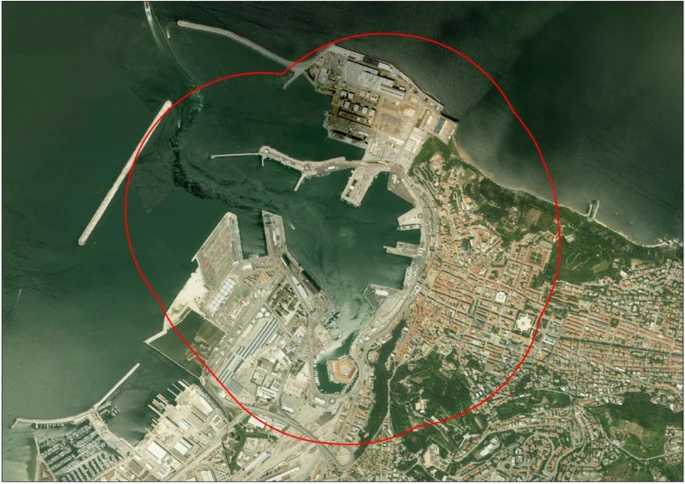Research - Open access
Federico Mei, Matteo Renzi, Martina Bonifazi, Floriano Bonifazi, Nicola Pepe, Alessio D’Allura, Giuseppe Brusasca, Giovanni Viegi & Francesco Forastiere
BMC Pulmonary Medicine volume 23, Article number: 395 (2023)
Abstract
Background
Shipping and port-related air pollution has a significant health impact on a global scale. The present study aimed to assess the mortality burden attributable to long-term exposure to ambient particulate matter (PM2.5, PM10) and nitrogen dioxide (NO2) in the city of Ancona (Italy), with one of the leading national commercial harbours.
City map with 800 × 800 m buffer centered
in the harbour area
Methods
Exposure to air pollutants was derived by dispersion models. The relationship between the long-term exposure of air pollution exposure and cause-specific mortality was evaluated by Poisson regression models, after adjustment for gender, age and socioeconomic status. Results are expressed as percent change of risk (and relative 95% confidence intervals) per 5 unit increases in the exposures. The health impact on the annual number of premature cause-specific deaths was also assessed.
Results
PM2.5 and NO2 annual concentrations were higher in the area close to the harbour than in the rest of the city. Positive associations between each pollutant and most of the mortality outcomes were observed, with estimates of up to 7.6% (95%CI 0.1, 15.6%) for 10 µg/m3 increase in NO2 and cardiovascular mortality and 15.3% (95%CI-1.1, 37.2%) for 10 µg/m3 increase PM2.5 and lung cancer. In the subpopulation living close to the harbour, there were excess risks of up to 13.5%, 24.1% and 37.9% for natural, cardiovascular and respiratory mortality. The number of annual premature deaths due to the excess of PM2.5 and NO2 exposure (having as a reference the 2021 World Health Organization Air Quality Guidelines) was 82 and 25, respectively.
Conclusions
Our study confirms the long-term health effects of PM and NO2 on mortality and reveals a higher mortality burden in areas close to shipping and port-related emissions. Estimating the source-specific health burdens is key to achieve a deeper understanding of the role of different emission sources, as well as to support effective and targeted mitigation strategies.


No comments:
Post a Comment